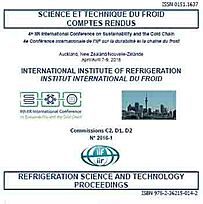
Document IIF
Analyse thermodynamique d'un système transcritique au CO2 de type "booster" utilisé dans les systèmes frigorifiques des supermarchés sous des climats chauds.
Thermodynamic analysis of CO2 trans-critical booster system for supermarket refrigeration in warm climatic conditions.
Auteurs : PUROHIT N., GUPTA D. K., DASGUPTA M. S.
Résumé
This article presents a thermodynamic analysis of a hypothetical trans-critical CO2 refrigeration system with enhanced booster and parallel compression for supermarket application in warm climatic conditions (35-50°C). The proposed system simultaneously incorporates two medium temperature and three low temperature loads for five different cooling demands typically found in supermarket application. These are HVAC load at 5°C, storage of dairy products at 0°C, frozen ice cream, vegetable and animal products at -10°C, -20°C and -30°C respectively. Some of the major parameters affecting performance like gas cooler operating pressure, inter-mediate vessel pressure, mass flow rate and gas cooler inlet temperature are investigated to reveal the practicality of the proposed system. The simulation results show that the new cycle configuration have distinct advantage over a few other modified cycles proposed from time to time for supermarket refrigeration in warm climatic conditions. A few potential improvement strategies of COP are also discussed.
Documents disponibles
Format PDF
Pages : 8
Disponible
Prix public
20 €
Prix membre*
Gratuit
* meilleur tarif applicable selon le type d'adhésion (voir le détail des avantages des adhésions individuelles et collectives)
Détails
- Titre original : Thermodynamic analysis of CO2 trans-critical booster system for supermarket refrigeration in warm climatic conditions.
- Identifiant de la fiche : 30017568
- Langues : Anglais
- Source : 4th IIR International Conference on Sustainability and the Cold Chain. Proceedings: Auckland, New Zealand, April 7-9, 2016.
- Date d'édition : 07/04/2016
- DOI : http://dx.doi.org/10.18462/iir.iccc.2016.0045
Liens
Voir d'autres communications du même compte rendu (63)
Voir le compte rendu de la conférence
Indexation
-
Thèmes :
CO2;
Supermarchés, meubles de vente - Mots-clés : Thermodynamique; Système frigorifique; Application commerciale; R744; Cycle transcritique; Frigorigène; Compression; CO2; Climat chaud
-
Transcritical CO2 systems: a case study into th...
- Auteurs : DA ROS S.
- Date : 08/06/2007
- Langues : Anglais
- Source : Technological innovations in air-conditioning and refrigeration industry + CD-ROM.
Voir la fiche
-
Laboratory evaluation of a commercial CO2 boost...
- Auteurs : FRICKE B., ZHA S., SHARMA V., et al.
- Date : 11/07/2016
- Langues : Anglais
- Source : 2016 Purdue Conferences. 16th International Refrigeration and Air-Conditioning Conference at Purdue.
- Formats : PDF
Voir la fiche
-
Recent developments in commercial refrigeration...
- Auteurs : CHIARELLO M., FORNASIERI E., MINETTO S., et al.
- Date : 21/08/2007
- Langues : Anglais
- Source : ICR 2007. Refrigeration Creates the Future. Proceedings of the 22nd IIR International Congress of Refrigeration.
- Formats : PDF
Voir la fiche
-
Design and experimental analysis of a carbon di...
- Auteurs : BERNABEI M., CECCHINATO L., CHIARELLO M., et al.
- Date : 07/09/2008
- Langues : Anglais
- Source : 8th IIR-Gustav Lorentzen Conference on Natural Working Fluids (GL2008)
- Formats : PDF
Voir la fiche
-
Supermarket application. Effects of sub-cooling...
- Auteurs : MAZZOLA D., SHEEHAN J., BORTOLUZZI D., et al.
- Date : 21/08/2016
- Langues : Anglais
- Source : 12th IIR Gustav Lorentzen Conference on Natural Refrigerants (GL2016). Proceedings. Édimbourg, United Kingdom, August 21st-24th 2016.
- Formats : PDF
Voir la fiche
